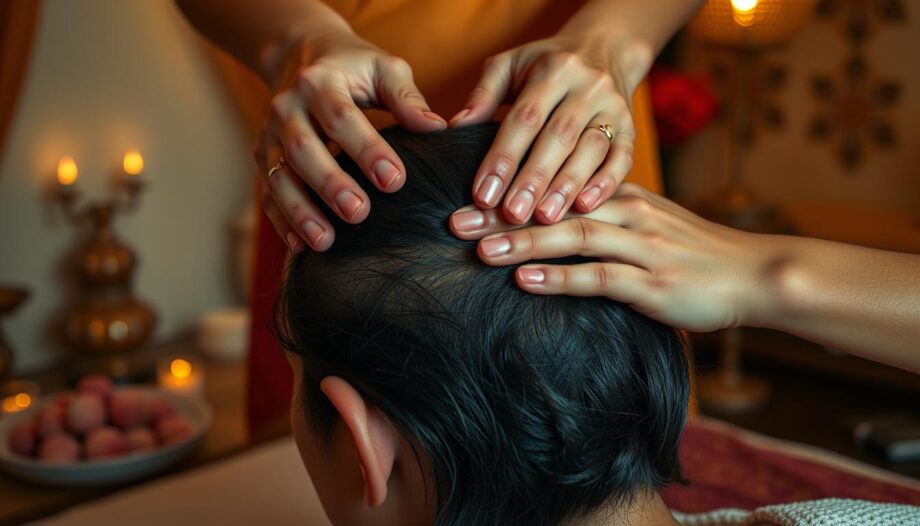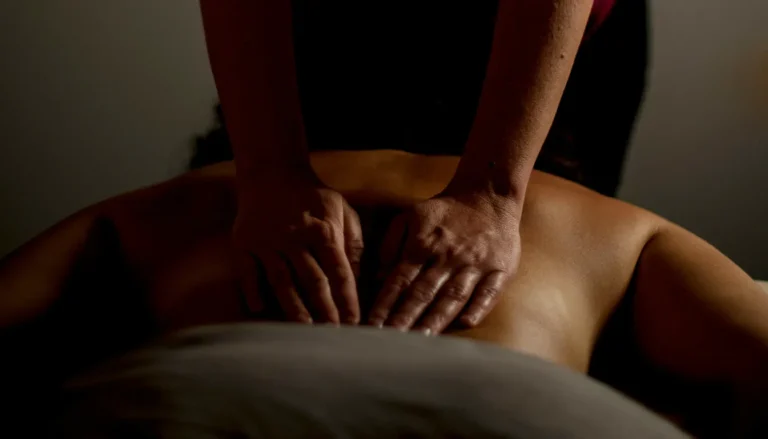Indian head massage targets acupressure points on the head, neck, shoulders, and face. It’s a practice from India over a thousand years old, now popular in the West for stress relief1. The benefits of Indian head massage include easing pain, improving sleep, and better skin health2. Techniques like Effleurage, Petrissage, Tapotement, and Friction help balance body energy and reduce tension1.
Adding essential oils such as lavender or coconut boosts the experience with emotional and physical gains3. Indian head massage, lasting 15 to 45 minutes, offers a break from daily stress and holds cultural importance in India and Turkey2.
What is Indian Head Massage?
Indian head massage, also called Champissage, is a form of healing from the Ayurveda tradition. It targets the head, neck, and shoulders, key areas for reducing stress and boosting well-being4. Each session lasts between 25 to 45 minutes, ideal for those looking to relax4. By enhancing blood circulation and lymph flow, it can ease problems like sinusitis and help you sleep better, supporting overall health4.
Understanding the Basics of Indian Head Massage
This massage practice has been a part of Indian family life for thousands of years4. Oils such as sesame, sweet almond, and olive are frequently used5. The fragrant oils used add to the massage’s benefits, making the experience more soothing. Clients are usually told to wash their hair after the treatment, to remove any oil smell before going out.
The Historical Context of Indian Head Massage
Originating as a health practice among Indian families, mothers would massage their children to maintain wellness4. Over time, this technique spread to various places, including barbershops and spas across the globe5. In the 1970s, Narendra Mehta introduced it to the West, securing its role in modern wellness routines.
| Feature | Description |
|---|---|
| Duration | Typically 25 to 45 minutes |
| Focus Areas | Head, neck, shoulders |
| Oils Used | Sesame, sweet almond, olive oil |
| Benefits | Stimulates blood flow, improves relaxation, aids sleep |
| Contraindications | Fever, migraine, infections |
Benefits of Indian Head Massage
Indian head massage is a holistic way to boost both body and mind health. It mixes different methods to offer many benefits. These aim to balance energy and help you relax.
Physical Benefits for the Body
Indian head massage is great for physical health. It eases pain and tension in your upper back, neck, and head. This can help reduce headaches and migraines6. The massage boosts lymphatic drainage. This helps get rid of toxins and improves blood flow7. Better blood flow means cells get more oxygen, supporting overall well-being.
Also, this massage can make sleep better. It works by calming your mind and helping you relax, which can fight insomnia6.
Mental and Emotional Benefits
The benefits for mental health are also strong. It helps lower anxiety and depression by improving brain oxygen levels7. People often say they can focus better and remember more after the massage. This therapy gives a deep sense of calm. It reduces stress and tiredness, making your mind clearer7.
It also can make you feel more energetic. This happens by balancing your body’s energy6.
| Benefit | Description |
|---|---|
| Relief from Headaches | Reduces tension and headaches6. |
| Improved Circulation | Boosts blood and oxygen flow to the body7. |
| Stress Reduction | Helps lower stress and anxiety, enhancing relaxation7. |
| Hair Growth Stimulation | Promotes better hair health and growth6. |
| Better Sleep | Improves sleep by promoting relaxation6. |
Indian Head Massage Techniques
Indian head massage includes many approaches with unique benefits. Each method helps relax and reduce tension in the upper body.
Effleurage: Soothing Strokes
Effleurage uses soft, flowing strokes to calm the muscles and boost blood flow. It makes the Indian head massage more relaxing and enjoyable.
Petrissage: Kneading Movements
Petrissage focuses on kneading tight spots, especially in the shoulders and upper back. It helps ease muscle knots and increases flexibility, leading to relaxation.
Tapotement: Tapping Techniques
Tapotement involves quick tapping that revives and refreshes the muscles. It wakes up nerve endings and boosts well-being.
Friction: Rubbing for Relief
Friction methods use rubbing to relieve sore areas. They ease tension and stiffness, adding comfort to the Indian head massage.
| Technique | Description | Benefits |
|---|---|---|
| Effleurage | Soothing gliding strokes | Enhances relaxation, promotes blood flow |
| Petrissage | Kneading movements | Relieves muscle knots, improves flexibility |
| Tapotement | Rhythmic tapping | Invigorates muscles, stimulates nerves |
| Friction | Rubbing actions | Alleviates tension and stiffness |
Preparing for an Indian Head Massage
Getting ready for an Indian head massage is key to make it calm and effective. The first move is
setting up the environment
Creating a quiet space is crucial. This means less noise and comfy seats. Playing soft tunes and dimming the lights can make the space peaceful. By adding candles, the room feels more relaxing. This setting helps the person enjoy the massage fully3.
choosing the right oils
Choosing the right oils can really boost the massage’s benefits. Lavender and frankincense oils add to the calm and ease stress3. They nourish the skin and help with hair. Sesame oil is good for its astringent effects, while coconut oil is great for its lightness and skin perks4. Both getting the space right and picking the best oils are key for a refreshing experience10.
Step-by-Step Guide to Performing Indian Head Massage
Knowing how to do an Indian head massage right is key for its full effects. This step-by-step Indian head massage focuses first on making you feel relaxed. It starts with easing your shoulders and neck, then moves to your scalp.
Starting with the Shoulders and Neck
The massage kicks off with focusing on your shoulder and neck. The masseuse uses soft moves to lessen tension in your shoulders. They move outward from there, gently massaging around your neck. This early stage is important as it gets your body ready for the scalp massage that follows. It boosts relaxation and the massage’s impact.
Massaging the Scalp
After easing your upper back, attention shifts to your scalp. The masseuse works in light, swirling touches at important spots. They use gentle stroking and quick rubs to make sure you relax fully. This massage technique not only eases your stress but can also help your hair grow. It gets your blood flowing better. This leads to feeling good all over by letting go of tension and11. Putting all these methods together makes this massage truly healing.
Conclusion
Indian head massage is a mix of old methods and total well-being ideas suitable for today’s wellness needs. It targets over 20 spots on the head, neck, and shoulders. This helps ease physical pain, stress, anxiety, and headaches1213. Using these practices often can boost your health by bettering blood flow and easing muscle tension.
People looking to find calm and balance will see why Indian head massage is great for easing stress14. It’s easy to learn and can greatly improve your mental and physical state. This makes it a key part of any health routine, leading to better sleep and less tension.
FAQ
What is Indian head massage?
Indian head massage, also known as Champissage, is a traditional therapy. It focuses on the acupressure points located in the head, neck, shoulders, and face. This method aims to balance your energy and reduce stress. It uses Ayurvedic techniques and has a history stretching over 600 years.
How long does an Indian head massage session last?
An Indian head massage usually takes between 30 to 45 minutes. Within this time, the therapist applies various techniques to help you relax and feel better.
What are the benefits of Indian head massage?
The benefits of this massage are vast. It helps ease migraines, tension, and improve sleep. It also promotes better lymph flow and boosts your energy levels. This contributes positively to your mental and emotional well-being.
What techniques are used in Indian head massage?
The massage includes different techniques like effleurage, petrissage, tapotement, and friction. These methods work together to relieve tension and encourage a state of relaxation.
How should one prepare for an Indian head massage?
Before getting a massage, make sure your space is calm and quiet. Playing soft music and turning down the lights can make a huge difference. Picking the right oil, like sesame or coconut oil, also enhances the massage experience.
Who can benefit from Indian head massage?
Anyone feeling stressed or tense could benefit. It’s great for people with headaches or those just looking for a way to relax. It suits anyone aiming to better their physical and mental health.
How often should I receive an Indian head massage?
How often you get a massage depends on what you feel is best for you. However, getting a massage at least once a month is a good idea for ongoing benefits.
Can Indian head massage help with hair growth?
Absolutely, Indian head massage can aid in promoting hair growth. It enhances blood flow to your scalp, nourishing the hair roots and improving your scalp’s health.
What oils are commonly used in Indian head massage?
Oils like sesame, coconut, and mustard are popular choices. Sesame oil is praised for its tightening effects, coconut oil for its moisture, and mustard oil for boosting blood flow.





